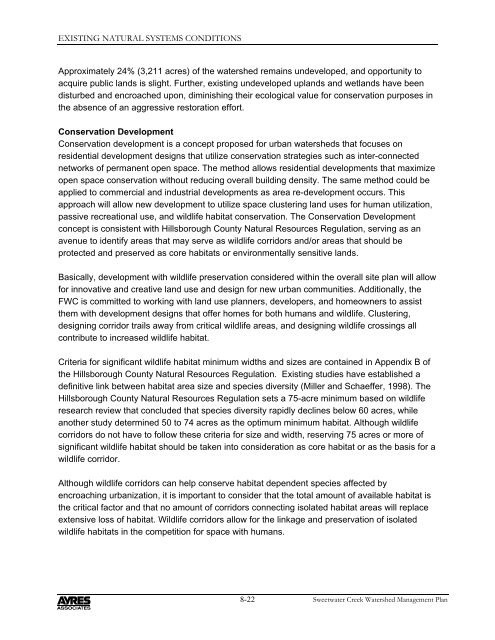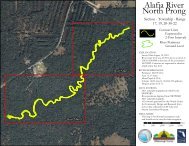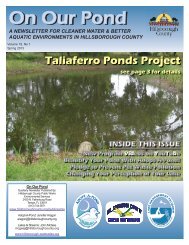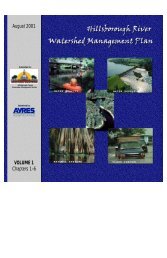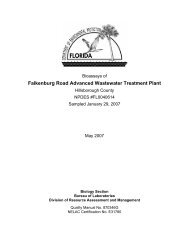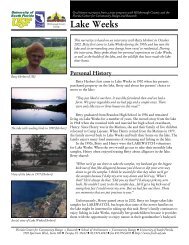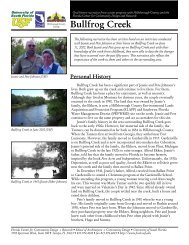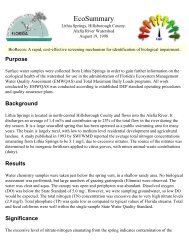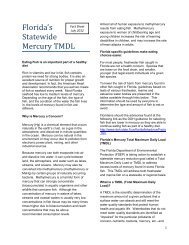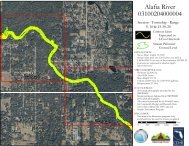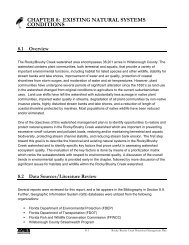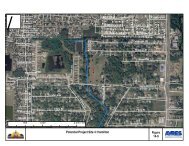Sweetwater Creek Watershed Mgmt. Plan 2007 Update--Part 2
Sweetwater Creek Watershed Mgmt. Plan 2007 Update--Part 2
Sweetwater Creek Watershed Mgmt. Plan 2007 Update--Part 2
Create successful ePaper yourself
Turn your PDF publications into a flip-book with our unique Google optimized e-Paper software.
EXISTING NATURAL SYSTEMS CONDITIONS<br />
Approximately 24% (3,211 acres) of the watershed remains undeveloped, and opportunity to<br />
acquire public lands is slight. Further, existing undeveloped uplands and wetlands have been<br />
disturbed and encroached upon, diminishing their ecological value for conservation purposes in<br />
the absence of an aggressive restoration effort.<br />
Conservation Development<br />
Conservation development is a concept proposed for urban watersheds that focuses on<br />
residential development designs that utilize conservation strategies such as inter-connected<br />
networks of permanent open space. The method allows residential developments that maximize<br />
open space conservation without reducing overall building density. The same method could be<br />
applied to commercial and industrial developments as area re-development occurs. This<br />
approach will allow new development to utilize space clustering land uses for human utilization,<br />
passive recreational use, and wildlife habitat conservation. The Conservation Development<br />
concept is consistent with Hillsborough County Natural Resources Regulation, serving as an<br />
avenue to identify areas that may serve as wildlife corridors and/or areas that should be<br />
protected and preserved as core habitats or environmentally sensitive lands.<br />
Basically, development with wildlife preservation considered within the overall site plan will allow<br />
for innovative and creative land use and design for new urban communities. Additionally, the<br />
FWC is committed to working with land use planners, developers, and homeowners to assist<br />
them with development designs that offer homes for both humans and wildlife. Clustering,<br />
designing corridor trails away from critical wildlife areas, and designing wildlife crossings all<br />
contribute to increased wildlife habitat.<br />
Criteria for significant wildlife habitat minimum widths and sizes are contained in Appendix B of<br />
the Hillsborough County Natural Resources Regulation. Existing studies have established a<br />
definitive link between habitat area size and species diversity (Miller and Schaeffer, 1998). The<br />
Hillsborough County Natural Resources Regulation sets a 75-acre minimum based on wildlife<br />
research review that concluded that species diversity rapidly declines below 60 acres, while<br />
another study determined 50 to 74 acres as the optimum minimum habitat. Although wildlife<br />
corridors do not have to follow these criteria for size and width, reserving 75 acres or more of<br />
significant wildlife habitat should be taken into consideration as core habitat or as the basis for a<br />
wildlife corridor.<br />
Although wildlife corridors can help conserve habitat dependent species affected by<br />
encroaching urbanization, it is important to consider that the total amount of available habitat is<br />
the critical factor and that no amount of corridors connecting isolated habitat areas will replace<br />
extensive loss of habitat. Wildlife corridors allow for the linkage and preservation of isolated<br />
wildlife habitats in the competition for space with humans.<br />
8-22<br />
<strong>Sweetwater</strong> <strong>Creek</strong> <strong>Watershed</strong> Management <strong>Plan</strong>


